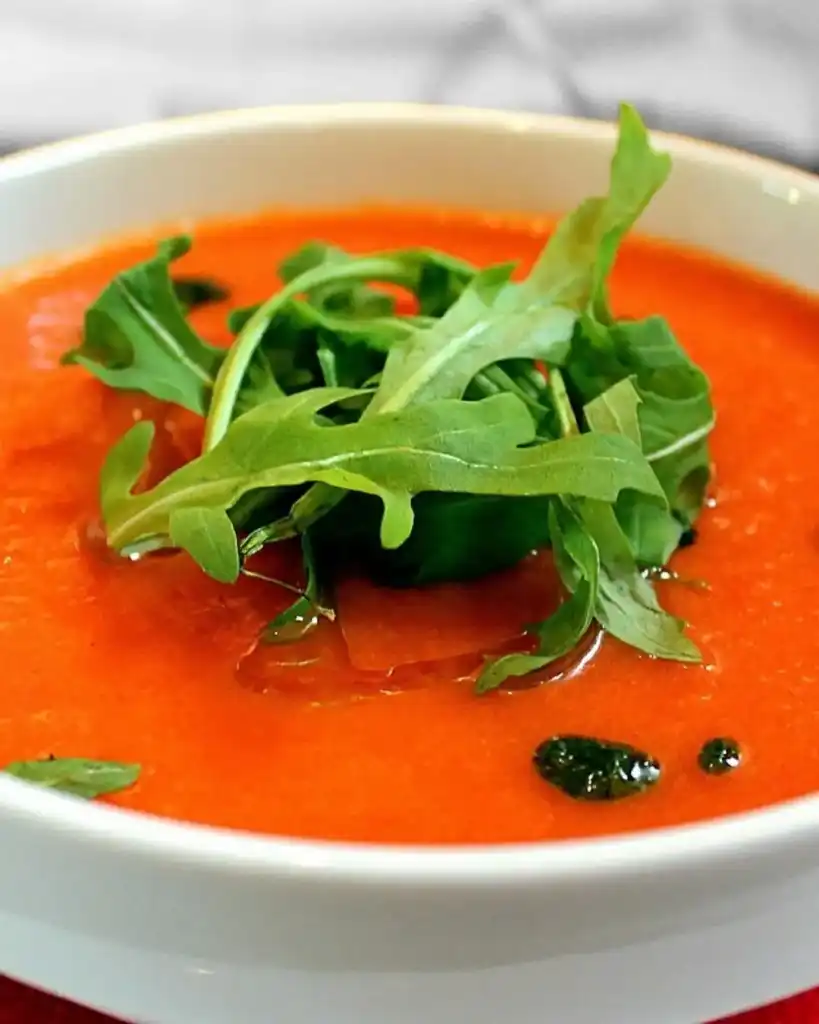Spanish cuisine offers many healthy food options that taste amazing. During my trip to Spain, I discovered foods that were delicious for me.
These foods aren’t just tasty. They’re packed with nutrients. Each one brings something special to your table and can improve your diet.
Let’s explore five healthy Spanish foods you can easily add to your diet. These simple options can make a big difference in how you eat.
1. Gazpacho: The Cool Soup That’s Full of Vegetables
Gazpacho is a cold soup made from fresh vegetables. It’s perfect for hot days when you want something refreshing and healthy.
The main ingredients are tomatoes, peppers, cucumbers, garlic, and olive oil. Everything is blended into a smooth, drinkable soup.
This Spanish favorite is loaded with vitamins. Raw vegetables contain all their nutrients since there’s no cooking involved.
Tomatoes give gazpacho its rich red color and provide lycopene, an antioxidant that is good for your heart and may help prevent certain types of cancer.
The olive oil helps your body absorb more nutrients from the vegetables. It also adds healthy fats that are good for your heart.
Making gazpacho at home is easy. You need a blender and fresh ingredients, and no cooking skills are required!
Serve it cold in small glasses as an appetizer or light meal. It’s perfect for summer and keeps well in the refrigerator.
2. Pescado a la Plancha: Simple Grilled Fish
Pescado a la plancha means “fish on the grill.” This cooking method lets the natural flavors of fresh fish shine through.
Spanish coastal towns serve this dish with fish caught that same day. The ingredients are minimal, just olive oil, garlic, and lemon.
The simplicity of this dish makes it so healthy. There are no heavy sauces or complicated preparations that add extra calories.
Fish provides lean protein and omega-3 fatty acids. These healthy fats support brain function and help reduce inflammation in your body.
Common fish choices include sea bream (dorado), sea bass (lumina), and hake (merluza). However, this cooking method works well with any white fish.
To make this at home, get the freshest fish you can find. Cook it quickly in a hot pan with olive oil, lemon, and salt.
This dish pairs perfectly with a simple green salad or grilled vegetables. The entire meal comes together in less than 20 minutes.
3. Aceitunas: Olives Packed with Healthy Fats
Spanish olives are more than just a snack. They’re essential to the Mediterranean diet and offer many health benefits.
Spain produces more olives than any other country. There are dozens of varieties, each with its unique flavor and texture.
These small fruits contain healthy monounsaturated fats. These “good fats” can help lower harmful cholesterol levels.
Olives provide vitamin E, iron, and calcium. They also contain compounds called polyphenols that fight inflammation in your body.
Olives are often served before meals in Spanish restaurants. They help stimulate digestion and prepare the body for the food to come.
Look for traditionally cured olives when possible. Many store-bought versions contain too much sodium and preservatives.
A small bowl of olives makes a perfect snack between meals. Their rich flavor satisfies hunger while providing healthy fats and nutrients.
4. Frutas Rojas: Berries Bursting with Antioxidants
Spanish berries are known for their exceptional flavor and nutritional benefits. The climate in Spain helps these fruits develop intense flavors.
Common Spanish berries include strawberries (fresas), blackberries (moras), blueberries (arándanos), and raspberries (frambuesas).
The bright colors of these berries indicate their high antioxidant content. These compounds help protect your cells from damage.
Berries are low in calories but high in fiber, making them perfect for satisfying sweet cravings without guilt.
Spanish people often enjoy berries as a simple dessert. They might add a touch of honey or a sprinkle of cinnamon rather than heavy sugar.
Adding berries to your breakfast is an easy way to increase your fruit intake. They go perfectly with yogurt, oatmeal, or whole-grain toast.
Fresh berries are best when in season, but frozen berries maintain most of their nutritional value. Keep some in your freezer for smoothies.
5. Frijoles/Lentejas: Beans and Lentils for Plant-Based Protein
Beans and lentils form the foundation of many traditional Spanish dishes. These humble foods have fed Spanish families for centuries.
Spanish cooks create flavorful stews, such as fabada asturiana (bean stew) and lentejas con chorizo (lentil stew with sausage).
These legumes provide plant-based protein, fiber, and complex carbohydrates. They give you lasting energy without blood sugar spikes.
Beans and lentils are budget-friendly superfoods. They cost little but provide excellent nutritional value for your money.
Spanish cooking often pairs small amounts of flavorful meat with beans or lentils. This adds depth of flavor while keeping the dish mostly plant-based.
For convenience, keep some canned beans in your pantry. Rinse them well before using them to reduce the sodium content.
A simple side dish of Spanish-style lentils takes about 30 minutes to prepare. The leftovers taste even better the next day for lunch.
How to Add These Spanish Foods to Your Diet
Start small by adding one Spanish food to your meals each week. This makes it easier to build new healthy habits.
Try making gazpacho when fresh tomatoes are in season. It’s a great way to use summer produce and stays fresh in the refrigerator for days.
Make fish night a weekly tradition in your home. Simple grilled fish with lemon takes minutes but offers significant health benefits.
Keep olives handy for healthy snacking. A small dish before dinner can help control your appetite and add nutrients to your day.
Add berries to your breakfast or enjoy them as a simple dessert. Their natural sweetness satisfies without added sugar.
You can also check:
Cook a big pot of beans or lentils on weekends for easy, healthy meals during the week. They’re perfect for meal prep and batch cooking.
These Spanish foods show that healthy eating doesn’t have to be complicated. Simple, quality ingredients prepared with minimal fuss can be delicious and nutritious.
Which of these Spanish foods will you try first? Even small changes to your diet can lead to better health over time.
Enjoy exploring these healthy Spanish options. Your taste buds and your body will thank you!





